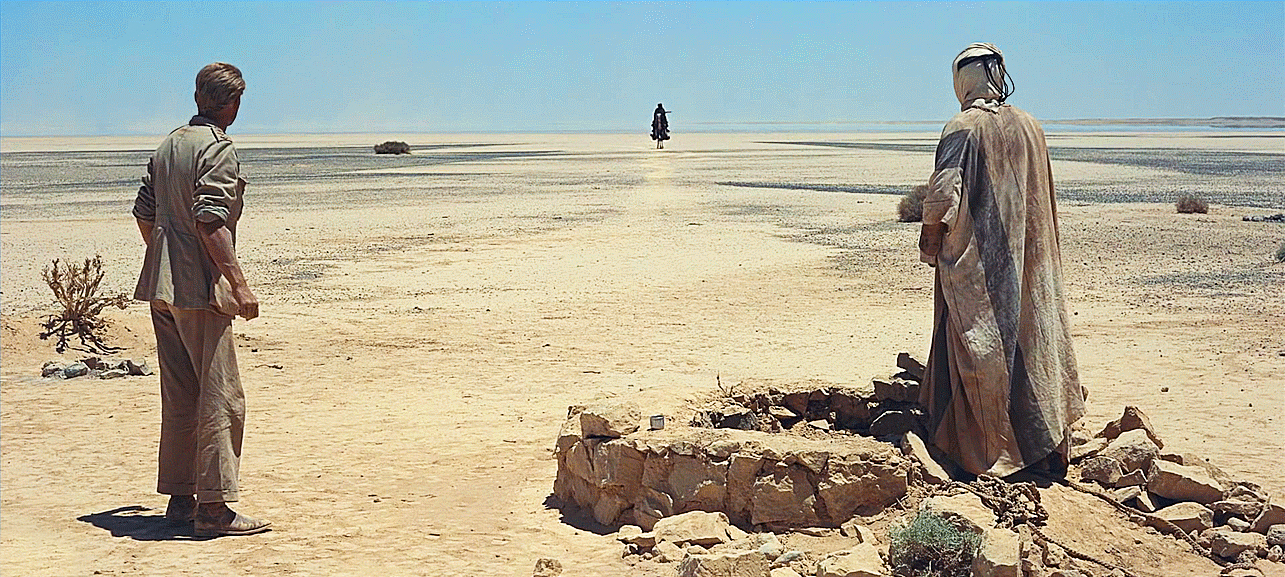
What Can It Show?
Sense of Place
A great location can become a character in the story and not just a generic backdrop. If you’ve found one, you might as well showcase it and not just “establish” it. Wide shots that show the characters interacting within the environment develop a sense of place and can help determine the tone of your story.
In Columbus (Kogonada, 2017), a student named Casey (Haley Lu Richardson) takes Jin (Jon Cho), who’s in town to visit his comatose father, on an architectural tour of Columbus, Indiana, a city known as a mecca for modern architecture. The two characters bond over the backdrop of Columbus and its landmarks.
The wide also helps establish the tone that the rest of the film will follow. It allows the viewer to feel like they are a bystander of this conversation, watching from afar. This is the second scene between Casey and Jin and all of the scenes after this follow a similar shot structure.
Loneliness
Isolation and loneliness can sometimes be challenging to show in a visual way, but wide shots are often a good place to start.
Christine (Antonio Campos, 2016) tells the true story of Christine Chubbock (played by Rebecca Hall), a young Florida news reporter struggling with depression in the 1970s. She’s frustrated both personally and professionally. In this clip notice how wide shots are used to introduce this lonely character.
Intimacy
Intimacy means closeness, so it is intuitive for filmmakers to represent intimacy through close-ups. But, wide shots, if used correctly, can also suggest intimacy.
In All the Real Girls (David Gordon Green, 2003) Paul (Paul Schneider) is a small town lothario who must change his ways when he falls for his best friend’s sister, Noel (Zooey Deschanel). In this scene, watch how the wide shots are used to create intimacy between Paul and Noel when their love is at its peak.
This scene shows the couple at a point in their relationship where they are comfortable being weird and goofy and very open with each other. While intimacy is usually shown in films by focusing on the characters’ eyes and how they look at one another, Paul and Noel rarely make eye contact. Instead, intimacy is shown through touch and physical closeness. The scene only uses two shots, both wides, with the final shot emphasizing their isolation as a couple, alone together.
Pacing
In dialogue scenes, cutting back and forth between shot-reverse-shot can become monotonous. Letting dialogue play out in a wide shot breaks the rhythm of this conventional editing. The same way quick cutting into mediums and close-ups might make an action scene more exciting, filming an important dialogue scenes in a wide shot allows your audience to pay more attention to what is being said by the characters.
In Catch Me If You Can (Steven Spielberg, 2002), Frank Abagnale, Jr. (Leonardo DiCaprio) is a young con man who has accepted a plea deal and must work with Carl Handratty (Tom Hanks), the straight-laced FBI agent who captured him. In this scene, Abagnale has become frustrated by dull office work and has decided to run away again.
Tension
From large blockbusters to small, personal indies, tension is something that is present in most films. Tension keeps the audience interested and invested in what happens next. It could be created in the writing, the editing, the musical score — or the shot selection.
In North by Northwest (Alfred Hitchcock, 1959), Roger Thornhill (Cary Grant) is an advertising executive who is mistaken for a spy named Kaplan and hunted by a secret organization intent on silencing him. In this scene, Thornhill takes a bus to an isolated location in order to meet with Kaplan, in hopes that the real spy will help clear his name. Watch how Hitchcock uses wide shots as a way to build tension within this scene.
Wide Shots on a Budget

Also, know how you will use the wide shot in your final film. If your shot is so wide you can barely see the actors’ faces, don’t worry about performances. If you know you’ll only cut to the wide at specific moments, don’t shoot the entire scene.
On the other hand, if you plan for most of the scene to play out in a wide (as a oner or a moving master, for instance) make sure you communicate that to your actors, and break the wide shot down into smaller chunks if possible. Take after take of an entire scene can wear out your talent and your crew, and could actually hurt their performance.
If you can schedule it, rehearse before you shoot. And not just with your cast, but with some of your key crew members like your director of photography and camera operator. On a low-budget production this can be tough, but even if you just take a few minutes to walk through it with everyone, it will be beneficial for the entire team. By covering most of your scene in a wide and only punching in for specific moments you might actually save time by reducing the amount of set-ups.

